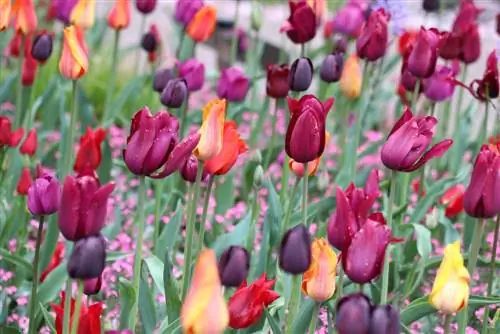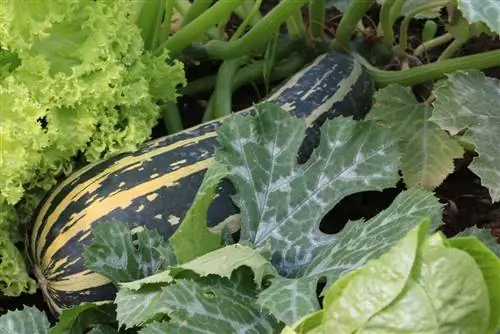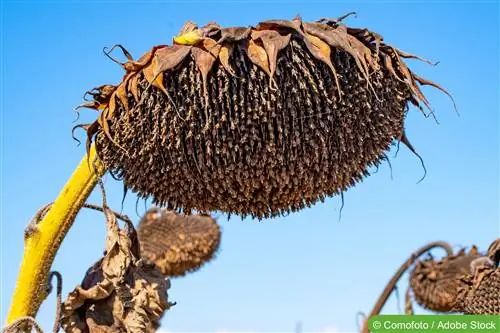- Author admin [email protected].
- Public 2023-12-17 03:39.
- Last modified 2025-06-01 06:48.
Cut off spent tulips - how to treat them? Tulips are a real eye-catcher, whether in the flower vase or in the flower bed. Hardly anyone doesn't like the sight of the vibrant and colorful flowers. Not only are tulips available in many different sizes and shapes, but the large selection of colors also ensures variety. This is one of the reasons why tulips are imported from all over the world. However, if you want to enjoy the blossoms in your own garden, you have to be prepared for the fact that the harbinger of spring will only show its blossoms for a very short time. Just two weeks after blooming, the splendor of colors in your own garden is already over.
After the flowering phase in spring, the now faded tulips begin to form seeds. This happens because after the tulip has faded, the stigma is pollinated. The ovary swells and new seeds are produced. However, this is a condition that is not desirable for tulips. The plant uses valuable energy to form the seeds. However, this energy is needed so that the tulip can produce its bulbs. Therefore, the flower heads that are slowly fading should be removed in spring.
Caring for the tulip after removing the flower heads
If the flower heads have been carefully cut off, the plant appears slightly desolate. However, the leaves remain and are still full of juice for some time. These leaves are normally required by the tulip for seed formation. However, by separating the spent heads, these juices are not needed. The plant still needs care in order to bloom again next year. The onion needs fertilization at regular intervals and also needs to be watered. This should happen until the leaves turn yellow. At this point, the bulbs are growing in the ground as the juices from the leaves now pass into the bulbs. As a result, the leaves turn yellow and lean towards the ground. At the end of this process, the leaves can be removed effortlessly.
This is a sign that the plant has drawn all its strength into the bulb and has rejected the part that grows above the ground. However, the leaves should be removed before they are completely dead and mushy. They are cut off at ground level when they turn slightly yellow. If you wait until they are muddy and moldy, areas of disease and putrefactive processes could arise. For the tulip, however, it is basically the same whether disease or rot occurs above ground. The above-ground part is removed to protect neighboring plants that can become infected with diseases from the rotting foliage.
Store the onions
If the flower heads were carefully cut off after flowering and the leaves were removed before they rotted, the bulbs can in principle remain in the ground until next year. However, once the bulbs are in the ground, they bore and grow deeper and deeper into it. This can mean that if the plants remain in the ground for a few years in a row, they can no longer make their way up when they sprout. In addition, waterlogging can quickly form, especially in heavy soils. If this happens, the bulbs can rot in the ground. The tulips gradually disappear from the bed. For these reasons, it is advisable to remove the bulbs from the ground after the leaves have faded. They should then be dried. This can be done in a dry place in the garden, winter garden or garden shed. Another option is to put the onions in a small net and hang them in a dry place.
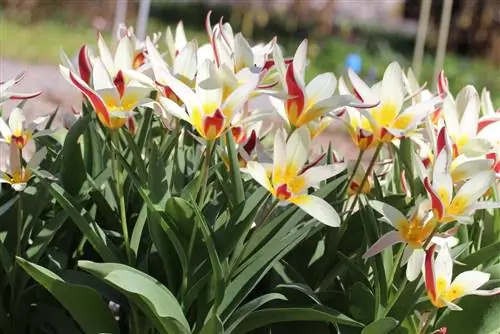
This saves space because the tulip bulbs don't have to lie spread out on the floor. The net can easily be hung under an eaves. However, so that the onions can survive this phase well, only he althy onions should be stored. Diseased onions should be sorted out before drying, as diseases can be transferred to he althy onions. Like all other diseased plants or plant residues, these diseased bulbs should not be added to the compost. From there, diseases that previously only affected one type of plant can spread throughout the entire garden. Such onions should therefore be disposed of in the trash can.
Until the tulips have faded
For many hobby gardeners, the blooming tulips are not a really pretty sight. Once the flowers are removed, only the green leaves are left. However, it is very important that these green leaves are not removed immediately with the flower heads. Even if it's not a feast for the eyes to have tulips with severed heads in the garden, these leaves fulfill an important function. The removal of the flower heads is only done under the aspect that the plant would form new seeds if the flower heads remained. However, for these seeds, the plant needs the energy needed to form the bulbs. However, since the bulbs will sprout faster than the seeds, the plant should be given the opportunity to use all of its strength to develop the bulbs.
For this to happen, however, the plant needs the energy from the remaining leaves. However, if the sight of the blooming tulips bothers you, you can move the tulips during this time. To do this, the bulbs are dug up and placed in a small furrow in the garden. During this phase, the blooming tulips can also be placed very close together. The tulips can stay here until the leaves have shrunk. The tulips stand here until they dry out. Therefore, they should only be watered once in their new location. The bed in which the tulips previously stood can now be used to plant other plants.
As sad as the sight of faded tulips may be for some, the plant is nonetheless alive.
A thoughtful approach from Mother Nature
Experts know that the so-called flower stigma is pollinated after flowering and as a result the ovary gradually swells. With the consequence that new seeds can now emerge.
Experienced (hobby) botanists also know that it is still advisable to avoid this condition because the actual plant energy dwindles during the seed formation process. Energy that the tulip primarily needs to stimulate the development of its breeding bulbs. It has been proven that these usually thrive much more quickly than seeds.
Action is needed in spring
Reason enough to remove the slowly withering flower heads. The plant certainly seems a little bit desolate now, but this should in no way be taken as an opportunity to pay no more attention to the tulip from now on. Quite the opposite.

It should rather be left alone and fertilized and watered at regular intervals. This special type of care is given to the plant from now on until the leaves begin to turn yellow. Now the time has finally come for the flower bulbs to grow in the ground.
Tip:
It happens again and again that tulip blossoms are ruthlessly torn down in cemeteries or front gardens for no apparent reason. There's no reason to be upset, because this by no means means the end of the spring flowers. The onions can definitely be used next year.
Flower care - with a difference
No matter whether the tulips were planted in a flower bed, in a pot or in a bucket: blooming tulips are indeed a real feast for the eyes.
The fresher the flowers are, the longer you can enjoy them when they shine in bright colors on the living room shelf or on the chest of drawers - beautifully arranged in a flower vase or trimmed as a bouquet.
However, the plant remains left behind are less attractive. However, removing these carelessly is not only unsightly but also senseless when you consider that with good care you can expect colorful tulips in the garden next year.
Because the tulip plants that become yellowish or brownish over time are no longer particularly attractive in pots, containers or beds, it makes sense to cover them up with perennials or beautiful bush plants.
First the perennials, then the tulips. Or vice versa?
Every hobby gardener should give their plants a rest period to give them the opportunity to gain new energy. While the tulip leaves turn yellow and the stems turn brown and wilted after the flowers are cut off, the plant bulb is busy storing nutrients.
Perennials or other plants will cover these unsightly areas in a very visually appealing way. But that's not all: the bulbs have enough scope to produce a wonderful display of flowers over the coming months.
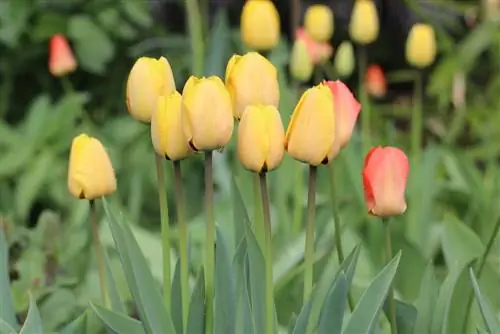
You can definitely speak of perfect timing here: because most perennial plants are cut back in spring to ensure denser growth, tulips have plenty of space at this time to develop in all their beauty. As soon as their flowering period has ended, the perennial plants can soon be expected to sprout.

